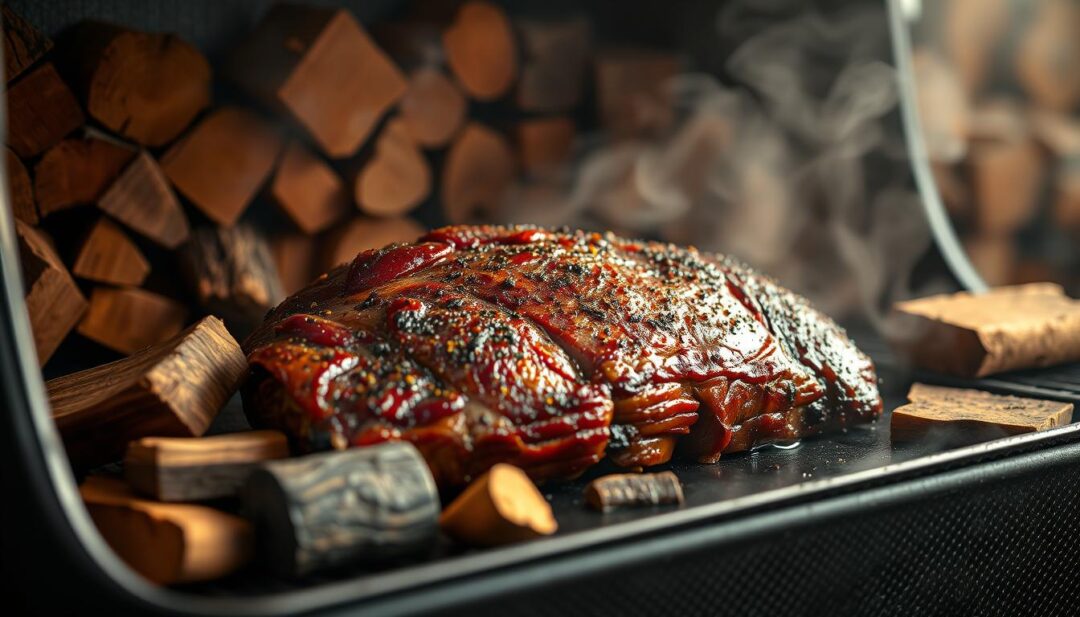There’s nothing quite like the anticipation of a perfectly smoked brisket on a lazy Sunday afternoon. The tender meat, the rich flavors, and that unmistakable smoky aroma all come together to create an unforgettable barbecue experience. But here’s the thing: the type of wood you use plays a huge role in achieving that mouthwatering result.
When it comes to smoking brisket, wood is the third essential element, right after heat and time. Different types of wood, like oak, apple, and mesquite, each bring their own unique smoky characteristics to the table. For instance, mesquite offers a bold, earthy flavor, while apple wood provides a sweeter, more delicate taste. The key is to find the perfect balance that complements the brisket without overpowering it.
Using high-quality, untreated wood is crucial not only for flavor but also for food safety. The right wood enhances the brisket’s natural taste, adding depth and complexity to its flavor profile. Whether you’re a seasoned pro or just starting your smoking journey, understanding how to pair wood with your brisket can make all the difference.
Introduction and Key Considerations
When it comes to smoking brisket, the type of wood you use is just as important as the meat itself. The right wood can elevate your brisket from a simple meal to a culinary masterpiece, adding layers of flavor that enhance the overall dining experience.
Understanding how different woods influence the flavor and texture of your brisket is crucial. For instance, hickory offers a strong, smoky flavor, while apple wood provides a sweeter, more delicate taste. Each wood type interacts with the meat differently, creating a unique flavor profile that can make or break your barbecue.
Proper wood preparation is another key aspect to consider. Soaking wood chips can help control the amount of smoke, ensuring your brisket isn’t overwhelmed by a heavy, overpowering flavor. Additionally, choosing the right wood for your smoker can enhance both the taste and appearance of your final dish.
In this guide, I’ll walk you through the process of selecting high-quality wood that complements your brisket perfectly. Whether you’re a seasoned pro or just starting out, understanding the basics of wood selection will help you achieve that perfect, mouthwatering brisket every time.
Wood Selection for Smoking: Understanding Flavor Profiles
When it comes to smoking brisket, the type of wood you use is just as important as the meat itself. The right wood can elevate your brisket from a simple meal to a culinary masterpiece, adding layers of flavor that enhance the overall dining experience.
Understanding how different woods influence the flavor and texture of your brisket is crucial. For instance, hickory offers a strong, smoky flavor, while apple wood provides a sweeter, more delicate taste. Each wood type interacts with the meat differently, creating a unique flavor profile that can make or break your barbecue.

Proper wood preparation is another key aspect to consider. Soaking wood chips can help control the amount of smoke, ensuring your brisket isn’t overwhelmed by a heavy, overpowering flavor. Additionally, choosing the right wood for your smoker can enhance both the taste and appearance of your final dish.
In this guide, I’ll walk you through the process of selecting high-quality wood that complements your brisket perfectly. Whether you’re a seasoned pro or just starting out, understanding the basics of wood selection will help you achieve that perfect, mouthwatering brisket every time.
Exploring Popular Woods for Brisket and Beyond
Choosing the right wood for smoking brisket can make a world of difference in the flavor and aroma of your final dish. Whether you’re aiming for a bold, smoky taste or a sweeter, more delicate profile, the type of wood you choose plays a crucial role.
Let’s explore some popular wood options:
- Mesquite is known for its strong, earthy flavor, making it perfect for quick-cooking meats. However, use it sparingly to avoid overpowering your brisket.
- Oak is a classic choice, offering a balanced, smoky flavor that complements brisket beautifully. It’s a reliable option for both beginners and experienced smokers.
- Hickory provides a robust, traditional BBQ flavor, while apple wood adds a fruity, slightly sweet taste that pairs well with poultry and pork.
Some woods, like alder and cherry, offer a mild smoky flavor, ideal for long cooking times. Others, like mesquite, deliver a bold punch better suited for shorter sessions. Experimenting with different types can help you discover your perfect flavor combination.
Remember, the key to achieving tender, flavorful meat is balance. Whether you’re smoking brisket, pork, or poultry, the right wood enhances the natural taste without overwhelming it. Over many BBQ sessions, I’ve learned that moderation and variety are key to creating unforgettable dishes.
Practical Tips for Smoking a Perfect Brisket
Smoking brisket is an art that combines patience, skill, and the right techniques. To help you master this craft, here are some practical tips to ensure your brisket turns out flavorful and tender every time.
First, always soak your wood chips in water before use. This helps them burn slower and produces consistent smoke. For gas grills, use a smoker box to contain the chips, while charcoal smokers can place the wood directly on the coals.
Next, monitor the wood closely, especially if using mesquite, as it can quickly become bitter. Start with small amounts and experiment with combinations like hickory and apple for a balanced flavor profile.
Finally, maintain optimal heat and smoke balance. This ensures even cooking and prevents the meat from drying out. By following these tips, you’ll achieve that perfect, mouthwatering brisket.
Wrapping Up Your Wood Smoking Journey
As you embark on your wood smoking adventure, remember that the right wood is more than just fuel—it’s a flavor partner. Whether you’re aiming for a bold, earthy taste or a sweet, smoky profile, the wood you choose can transform your brisket into a culinary masterpiece.
From the robust tang of mesquite to the balanced richness of oak, each wood type brings its own unique character to the table. Experimenting with different flavors and combinations will help you discover what works best for your brisket. Don’t be afraid to mix and match—like pairing hickory’s boldness with the fruity sweetness of apple wood.
Always consider smoke density and flavor intensity. Soaking your wood chips and monitoring the smoke during cooking ensures a perfect balance. Remember, the goal is to enhance the brisket’s natural flavor without overpowering it.
With these guidelines, whether you’re a novice or a seasoned pro, you’re equipped to create unforgettable, flavor-packed brisket. Confidence in your wood selection will shine through in every delicious bite. Happy smoking!



